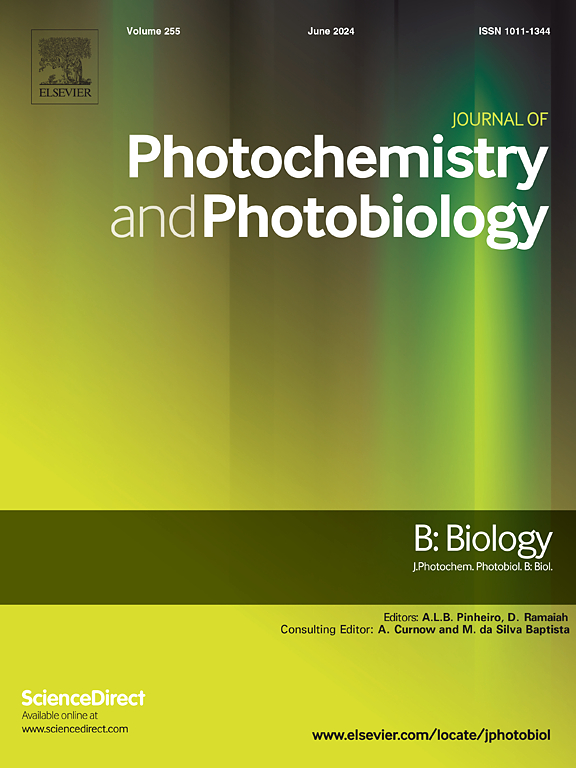低剂量265 nm UVC的体外抗生物膜效果。
IF 3.9
2区 生物学
Q2 BIOCHEMISTRY & MOLECULAR BIOLOGY
Journal of photochemistry and photobiology. B, Biology
Pub Date : 2025-02-01
DOI:10.1016/j.jphotobiol.2024.113091
引用次数: 0
摘要
目的:临床前研究证实了窄带低强度紫外线C光(UVC)治疗细菌性角膜感染的安全性和有效性。为了进一步巩固这些发现,本研究旨在探索低强度UVC光在生物膜相关感染中的体外抗生物膜功效。方法:铜绿假单胞菌生物膜在室孔载玻片中培养48 h,暴露于UVC(波长265 nm,强度1.93 mW/cm2)下15 s、30 s、60 s或120 s, 70%丙醇(阳性对照)或不暴露(阴性对照)。在激发暴露后1小时、4小时、6小时和8小时进行细菌LIVE/DEAD染色,以评估生物膜失活的时间模式,并使用共聚焦显微镜对载玻片进行成像。以不同处理组在各时间点的死膜生物量(体积/面积- μm3/μm2)来量化处理效果。结果:在暴露后的每个时间点,酒精和uvc激发组的死亡生物膜生物量始终高于未激发组(p 0.05)。通过共聚焦显微镜观察,UVC暴露的生物膜在1 h时主要表现为中期生物膜(即死亡状态),并在4 h时发展为死亡生物膜。结论:低剂量的UVC显示出有效的抗生物膜活性,即使在短时间内暴露15 s,这一剂量之前被认为对体内角膜感染有效。这些数据支持这种基于UVC光的技术作为一种经济、方便和有效的治疗与细菌生物膜相关的眼部感染的方法的潜力。本文章由计算机程序翻译,如有差异,请以英文原文为准。
In vitro anti-biofilm efficacy of therapeutic low dose 265 nm UVC
Purpose
Preclinical studies have confirmed the safety and efficacy of narrowband low-intensity ultraviolet C light (UVC) in managing bacterial corneal infection. To further consolidate these findings, the present study aimed to explore in vitro anti-biofilm efficacy of low-intensity UVC light for its potential use in biofilm-related infections.
Methods
Pseudomonas aeruginosa biofilm was grown in chamber well slides for 48 h and exposed to one of the following challenges: UVC (265 nm wavelength, intensity 1.93 mW/cm2) for 15 s, 30 s, 60 s or 120 s duration, 70% propanol (positive control), or no exposure (negative control). Bacterial LIVE/DEAD staining was conducted at 1 h, 4 h, 6 h and 8 h after challenge exposures to assess the temporal pattern of biofilm inactivation, and slides were imaged using confocal microscopy. Treatment efficacy was quantified by dead biofilm biomass (volume/area - μm3/μm2) for different treatment groups at each time point.
Results
At each time point post-exposure, dead biofilm biomass was consistently higher in the alcohol- and UVC-challenged groups than in the unchallenged control (p < 0.05), suggesting a sustained biocidal impact after a given challenge. The quantity of dead biofilm biomass did not differ between UVC groups at any time point (p > 0.05). Observed by confocal microscopy, UVC-exposed biofilm demonstrated predominantly intermediate-stage biofilm (i.e., dying state) at 1 h, which progressed to dead biofilm by 4 h.
Conclusion
Low doses of UVC demonstrated potent anti-biofilm activity, even in exposures as short as 15 s, the dose that has previously been deemed to be effective in managing corneal infection in vivo. These data support the potential for this UVC light-based technology to serve as an affordable, convenient, and effective means of treating ocular infections associated with bacterial biofilm.
求助全文
通过发布文献求助,成功后即可免费获取论文全文。
去求助
来源期刊
CiteScore
12.10
自引率
1.90%
发文量
161
审稿时长
37 days
期刊介绍:
The Journal of Photochemistry and Photobiology B: Biology provides a forum for the publication of papers relating to the various aspects of photobiology, as well as a means for communication in this multidisciplinary field.
The scope includes:
- Bioluminescence
- Chronobiology
- DNA repair
- Environmental photobiology
- Nanotechnology in photobiology
- Photocarcinogenesis
- Photochemistry of biomolecules
- Photodynamic therapy
- Photomedicine
- Photomorphogenesis
- Photomovement
- Photoreception
- Photosensitization
- Photosynthesis
- Phototechnology
- Spectroscopy of biological systems
- UV and visible radiation effects and vision.

 求助内容:
求助内容: 应助结果提醒方式:
应助结果提醒方式:


